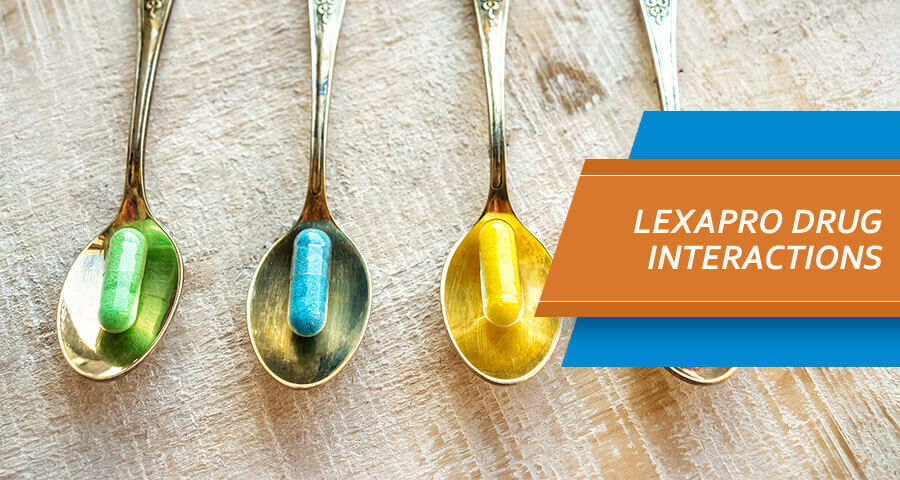
Lexapro is commonly prescribed as an antidepressant and anxiolytic, primarily used to treat major depressive disorder (MDD) and generalized anxiety disorder (GAD).
Lexapro interactions include numerous potential hazards ranging from mild to severe. The medication interacts with over 600 other drugs, with 38% causing severe effects and 55% resulting in moderate side effects. Major interactions occur with other serotonergic medications, creating risk for serotonin syndrome—a potentially life-threatening condition. NSAIDs and warfarin increase bleeding risks when combined with Lexapro. Benzodiazepines intensify sedation effects. Alcohol consumption worsens depressive symptoms and interferes with treatment efficacy. Mild interactions exist with substances like Benadryl and marijuana. Patients taking Lexapro benefit from professional guidance regarding all potential drug interactions.
Lexapro is a therapeutic option for the estimated 21.0 million adults in the United States that had suffered at least one major depressive episode. This number represented 8.3% of all U.S. adults. Its efficacy is well-known, but interactions with other drugs may pose major health risks.
Table Of Contents:
What is Lexapro?
Trade name: Lexapro®
Generic name: Escitalopram
Lexapro, also known as Escitalopram, is a selective serotonin reuptake inhibitor (SSRI), functioning by increasing serotonin levels in the brain. This neurotransmitter is crucial in regulating mood, emotions and mental well-being.
Primarily prescribed for the treatment of major depressive disorder and generalized anxiety disorder, Lexapro is also used to manage other conditions such as social anxiety disorder and panic disorder. Escitalopram is known for its interactions with a variety of substances, including alcoholic drinks, weed and over 600 medications.
These interactions are classified based on severity. A common question among Lexapro users is, ‘Can I take Benadryl with Lexapro?’ The answer is no, but interactions between Benadryl and Lexapro have not been reported as serious, and interactions with other drugs may cause significant health risks.
Top 9 Lexapro Interactions
Lexapro comes with a web of potential interactions that vary in severity. These interactions are categorized into four classes – major, moderate, minor and unknown – based on the associated risks. Around 38% of the drugs with known Escitalopram interactions result in severe effects and 55% cause moderate side effects.
Major Lexapro Interactions
Serotonin Syndrome
When Lexapro is used concurrently with other serotonergic drugs, the risk of serotonin syndrome significantly escalates. This syndrome results from an excessive accumulation of serotonin in the central nervous system, causing a range of symptoms that can be severe and life-threatening.
Unlike an interaction between Benadryl and Lexapro, serotonin syndrome is serious side effect characterized by a constellation of symptoms, including agitation, hallucinations, rapid heart rate, high blood pressure, dilated pupils, muscle rigidity, tremors and in severe cases, hyperthermia and seizures.
This interaction requires prompt intervention. Drugs that contribute to serotonin syndrome with Lexapro:
- Selective serotonin reuptake inhibitors (SSRIs): Fluoxetine (Prozac), paroxetine (Paxil), and sertraline (Zoloft).
- Serotonin and norepinephrine reuptake inhibitors (SNRIs): Venlafaxine (Effexor) and duloxetine (Cymbalta)
- Tricyclic antidepressants (TCAs): Amitriptyline and nortriptyline.
- Monoamine oxidase inhibitors (MAOIs): Phenelzine and tranylcypromine.
- Triptans: Sumatriptan.
- Street drugs: Ecstasy (MDMA), cocaine, lysergic acid diethylamide (LSD).
Monoamine Oxidase Inhibitors (MAOIs)
MAOIs are a class of antidepressants that block the activity of the enzyme monoamine oxidase, which plays a role in the breakdown of neurotransmitters like serotonin, norepinephrine and dopamine.
Unlike the interaction of Benadryl and Lexapro, Lexapro combined with MAOIs, lead to the inhibition of monoamine oxidase, leading to an excess accumulation of neurotransmitters in the synaptic cleft. This synergistic effect creates a heightened risk of a hypertensive crisis.
Types of MAOIs:
- Non-selective MAOIs: Examples include phenelzine and tranylcypromine.
- Selective MAO-B inhibitors: Selegiline, when used at higher doses than those typically used for Parkinson’s disease.
Lexapro and Alcohol
A common question among the general public is, can I take Lexapro with alcohol? The short answer is that escitalopram and drinking alcohol should be avoided at all times.
The complete explanation is a little more complex, so let’s dive into what happens when you mix Lexapro with alcohol. Drinking while on Lexapro poses a heightened risk for individuals, as it dualistically impacts the central nervous system, potentially worsens depressive symptoms, and interferes with medication absorption. Unlike the interaction of Benadryl and Lexapro, when mixed with alcohol, it can lead to increased accidents and diminished cognitive function.
Moderate Lexapro Interactions
Non-Steroidal Anti-Inflammatory Drugs (NSAIDs) and Lexapro
The additive effect of Lexapro and NSAIDs on bleeding risk significantly heightens the potential for adverse gastrointestinal events, such as bleeding and bruising. This interaction is particularly concerning for individuals who are already predisposed to gastrointestinal issues or are taking other medications that increase bleeding risk.
It is essential for individuals taking Benadryl and Lexapro or any NSAIDs concomitantly to do so under strict medical supervision.
Warfarin
Warfarin is widely prescribed to reduce the risk of blood clots by inhibiting the synthesis of certain clotting factors. Lexapro, on the other hand, influences serotonin levels in the brain.
When used concurrently, there is a risk of altering bleeding time, as both medications can independently affect the balance required for proper blood clotting. Responses to this interaction may vary among individuals. Factors such as age, health status and genetic predispositions can influence the extent of the interaction and its consequences.
Benzodiazepines
You have probably heard that lorazepam and Lexapro are a dangerous combination. In fact, Lexapro and benzodiazepines can individually induce sedative effects. Combining these medications may result in an additive effect, intensifying feelings of drowsiness and sedation.
Similar to Benadryl and Lexapro, this interaction can impair alertness and cognitive function, influencing daily activities that require mental and motor coordination.
Several benzodiazepines may interact with Lexapro, potentially magnifying sedative effects. Some of these include:
- Alprazolam (Xanax)
- Diazepam (Valium)
- Lorazepam (Ativan)
- Clonazepam (Klonopin)
- Temazepam (Restoril)
- Chlordiazepoxide (Librium)
- Oxazepam (Serax)
- Clorazepate (Tranxene)
- Midazolam (Versed)
- Triazolam (Halcion)
CYP2C19 Inhibitors
CYP2C19 inhibitors interfere with the metabolic breakdown of Lexapro, leading to increased concentrations of the antidepressant in the bloodstream. Elevated Lexapro levels may heighten the risk of side effects, potentially impacting the medication’s safety and efficacy.
Several medications act as CYP2C19 inhibitors and may interact with Lexapro. Some of these include:
- Fluconazole (Diflucan)
- Fluoxetine (Prozac)
- Fluvoxamine (Luvox)
- Cimetidine (Tagamet)
- Esomeprazole (Nexium)
- Omeprazole (Prilosec)
- Lansoprazole (Prevacid)
- Rabeprazole (Aciphex)
- Clopidogrel (Plavix)
- Voriconazole (Vfend)
Mild Interactions, Benadryl and Lexapro, Others
Marijuana (Weed)
Only in the U.S, youth with depression have reported cannabis use at twice the rate, and the prevalence of cannabis use among depressed teens has risen more rapidly over the past 15 years compared to their peers.
Approaching this interaction is not only important but necessary. Well, then you must be thinking, does weed interact with Lexapro?
Combining Lexapro with marijuana introduces potential interactions that primarily manifest as increased risks of drowsiness and cognitive impairment. This is particularly relevant for individuals in professions or situations where mental acuity is crucial.
Benadryl (Diphenhydramine)
This interaction is highly searched for, especially during spring.
Benadryl, an over-the-counter antihistamine containing diphenhydramine, is commonly used to relieve allergy symptoms, hay fever and as a sleep aid. It’s widely available in various forms and can be purchased over the counter in pharmacies and grocery stores.
Combining Benadryl and Lexapro introduces a mild interaction that may result in heightened drowsiness and sedation. Monitoring for excessive sedation is advisable to ensure the safety and well-being of individuals using this combination.
Dramamine (Dimenhydrinate)
Combining Lexapro and Dramamine could increase adverse effects like dizziness, drowsiness, confusion, and impaired concentration. Certain individuals, particularly older adults, may have diminished cognitive abilities, impaired judgment, and reduced motor coordination.
Unknown Drug Interactions with Escitalopram
Some common drugs with lacking information / unknown interactions with Escitalopram to date are melatonin, Tylenol (acetaminophen), and sudafed (Pseudoephedrine). Since melatonin has sedative effects, we can assume that a combination with Escitalopram might result in extreme drowsiness. However, an interaction between Lexapro and Tylenol is very unlikely.
Seek Professional Guidance
The spectrum of drug interactions with Escitalopram spans from minor inconveniences like Benadryl and Lexapro to severe complications, with a considerable number of medications showing major interactions. Concurrent use with others requires medical intervention.
Patients must receive proper counseling and explicit warnings against abruptly discontinuing their antidepressant medication. Abrupt cessation can lead to the development of Lexapro withdrawal syndrome, underscoring the importance of a gradual and supervised tapering process guided by healthcare professionals.
People Also Ask
Can you take Benadryl while on Lexapro?
Yes, you can take Benadryl while on Lexapro, but caution is advised due to potential increased drowsiness. Consult your healthcare provider for personalized advice based on your medication regimen.
Can you take Benadryl with antidepressants?
Taking Benadryl with antidepressants is a moderate interaction, potentially increasing drowsiness. Like Benadryl and Lexapro, side effects may vary and personalized advice ensures safe use.
What drugs should not be taken with Lexapro?
Avoid combining Lexapro with MAOIs (Monoamine Oxidase Inhibitors), serotonergic drugs, CNS stimulants, and anxiolytics. Consult your healthcare provider for personalized advice to prevent potential serious interactions.
Hope Without Commitment
Find the best treatment options. Call our free and confidential helpline
Most private insurances accepted
Find Drug Rehabilitation Centers Near You Anywhere In the US
Addiction Resource team has compiled an extensive list of the top drug rehabilitation facilities around the country. Use our locator tool to find the best centers near you.
Page Sources
- Major Depression. (n.d.). National Institute of Mental Health (NIMH). - Retrieved on february 2, 2024
- Landy, K. (2023, November 10). Escitalopram. StatPearls - NCBI Bookshelf. - Retrieved on february 2, 2024
- Foong, L., Grindrod, K. A., Patel, T., & Kellar, J. (2018). Demystifying serotonin syndrome (or serotonin toxicity). Canadian Family Physician, 64(10), 720-727. - Retrieved on february 2, 2024
- Aldrich, S. L., Poweleit, E. A., Prows, C. A., Martin, L. J., Strawn, J. R., & Ramsey, L. B. (2019). Influence of CYP2C19 Metabolizer Status on Escitalopram/Citalopram Tolerability and Response in Youth With Anxiety and Depressive Disorders. Frontiers in Pharmacology, 10. - Retrieved on february 2, 2024
- Weinberger, A. H., Zhu, J., Lee, J., Anastasiou, E., Copeland, J., & Goodwin, R. D. (2020). Cannabis use among youth in the United States, 2004–2016: Faster rate of increase among youth with depression. Drug and Alcohol Dependence, 209, 107894. - Retrieved on february 2, 2024


 Reviewed by:
Reviewed by:  Written by:
Written by: 

 FindTreatment.gov
FindTreatment.gov